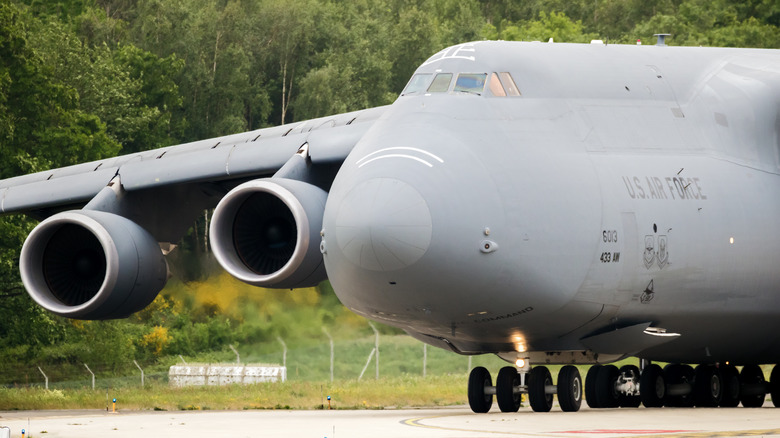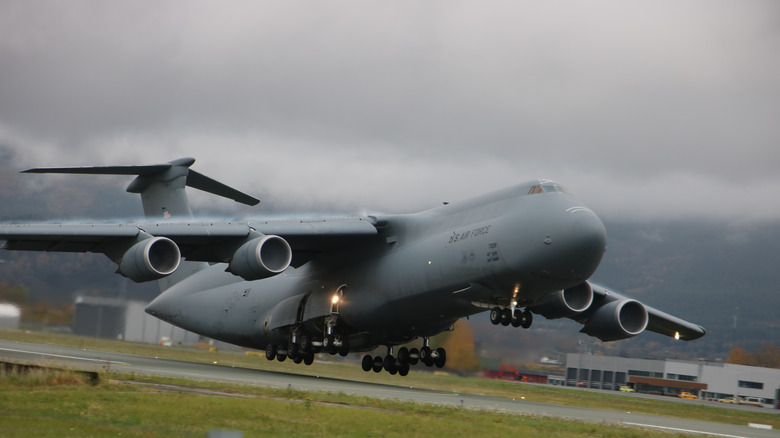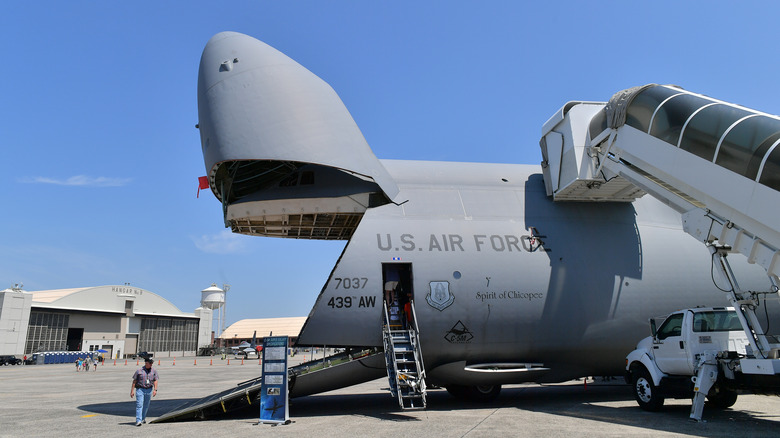The Unrivaled Capabilities Of The Massive C-5M Super Galaxy
Aircraft are tailored to their intended purpose during the design and construction process. This purpose can and often does differ from the initial concept as time passes (perhaps development is delayed and technology or circumstances change during the process), but specialism is essential.
For instance, a jet fighter will prioritize speed and maneuverability if intended to fight air-to-air combat to protect less agile aircraft from attack. Bombers, meanwhile, can be heavyweight aircraft, like the massive and powerful Convair B-36 Peacemaker. The priority with such aircraft is to cover long distances and to be able to unleash tremendously powerful ordinance with as much accuracy as they can muster. The C-5M Super Galaxy was cut from a similar cloth and is a genuinely intimidating aircraft.
It is not armed, and while it may seem like a simple (if gigantic) transport aircraft, it boasts some truly stellar capabilities. Let's take a look at what this powerful plane can do.
The creation of the C-5M Super Galaxy
Guinness World Records states that Earth's largest aircraft by wingspan is the Stratolaunch, which flexed its absurd 385-foot (117.35 meters) wingspan for the first time in May 2017. The Super Galaxy isn't quite that large, at almost 223 feet (67.9 meters) from wingtip to wingtip and standing 65 feet (19.84 meters) tall, but it's an imposing sight indeed and the largest aircraft in the United States Air Force.
The Super Galaxy began life as the C5-A Galaxy, a Lockheed behemoth that was intended for long-distance transport of cargo and lots of it. In January 1970, The Times-News reported that only ten of what was intended to be a fleet of 81 (a total already cut down as costs mounted) C5s were complete when a design flaw came to light: cracks in the wings, seemingly caused by its unique design — a lower fuselage and high-mounted wings allowing for quick storing and removal of cargo — were at fault.
The C5-B was the result of an additional $1.4 billion investment, an improved aircraft with secure wings, and numerous other upgrades besides. Before 1990, C5-Bs had been joined by two C5-Cs, which were adapted for space shuttle cargo by increasing space inside and access door size. Just under a decade later, the existing aircraft were modified further to become the C-5M Super Galaxy.
What's so super about the C-5M Super Galaxy?
From its very first iteration, it was clear that the C-5 was very special. The Times-News wrote of the aircraft, "The Galaxy, almost as long as a football field, is capable of carrying 22,000 pounds –- or 375 fully armed troops –- a distance of more than 3,000 miles." Decades of upgrades later, it proved just how formidable it could be.
By 2017, some of the aircraft had been removed from service. Still, thanks to the attention of the Reliability Enhancement and Re-engineering Program and the broader C-5 Avionics Modernization Program, the Super Galaxy was equipped with new General Electric CF6-80C2-L1F engines, advanced autopilot, and a lot more. It's faster, stronger, safer, and quieter than an aircraft of its size has any right to be. A speed of 518 miles per hour with a total cargo of 281,001 pounds were impressive numbers for the Super Galaxy to build upon. A Lockheed Martin press release from May 2006, demonstrating a newly-modified Super Galaxy, boasted a capacity to fly in all weathers, to reach further afield, and to perform more cost-effectively.
The Air Force plans to keep the Super Galaxy successors in service for some time to come. A range of sophisticated systems for keeping track of other aircraft and surrounding systems are planned, too. As with the X-15, There's no other aircraft like it.


